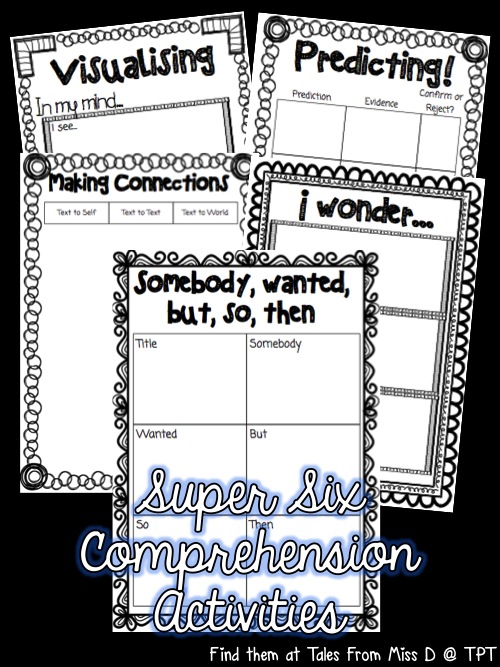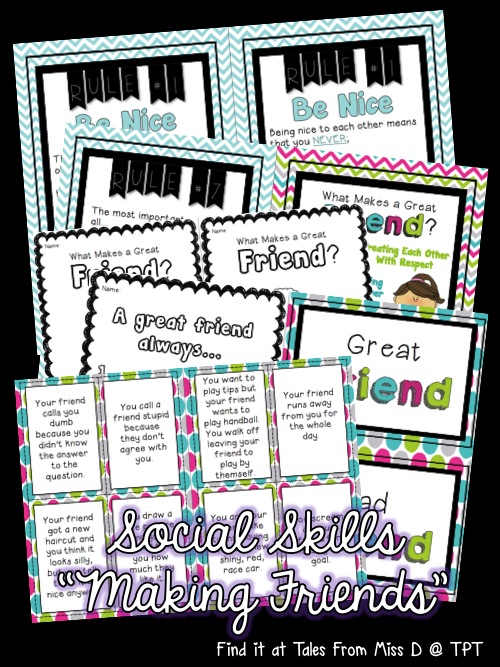One of my favourite things to teach on a relief day is something related to comprehension. When I say comprehension I'm not talking about those 'read a passage and answer some basic questions' activities, I'm talking about
metacognitive strategies.
One of the biggest impacts on my teaching was the 2 year long professional development program that I participated in while on year 1. The things I learned in that program have stuck with me and have changed the way I teach. I noticed a positive impact in my students growth, so of course I am passionate about it and keep on finding new ways to implement it in my teaching. This is reflected in my TPT store as quite a few of my products relate to comprehension.
Over the next few posts I will be sharing my knowledge and experiences as well as some teaching ideas :)
The Super Six Comprehension Strategies
Obviously this is the starting point as the rest of the ideas all relate back to the strategies. A while ago, I wrote a post about how I introduced them to my year 1 class. You can read all about that over
here.
I recently revamped the strategies into 'Super Powers'. Kids love Super Heroes, so I thought that it would be cool to have a 'We can be reading superheroes by using our Super Six Comprehension Powers' theme. I think it works pretty well as by using these "super powers" they are able to have a deeper understanding of what they are reading :)
If I were on class, I'd have a wall with each poster hanging up and student work on display underneath each poster to form a wall that teaches. The work would rotate regularly to keep it fresh and be relevant to the topic that we are covering. Sounds like a lot of work, but it's really not that hard. The pride the students have when their work is up makes it worth it :)
My role is different this year, so what I do with these strategies is sort of the same but different. I'll use all the strategies with each text that we read, but I'll have a focus lesson on one of the strategies. In the lesson we define what the strategy is, what we do with it and how it helps us. Why do I do a focus lesson? because I think it's always beneficial to brush up on these skills! As a classroom teacher, I loved when a relief teacher would do a lesson that recapped key skills because there are always some kids that could do with that extra practice.
Examples of focus lessons for each strategy;
Visualising - read a section of text and have students draw what they think the character/scene/object looks like. Students label their picture and then write sentences to describe. By getting students to label you can what clues they used to form their visualisation (i.e it the text mentioned that the monster has red, bloodshot eyes and the student uses that exact label you can see that they have been paying close attention).
Making Connections - read the text and students use a sentence starter to write and draw their connections.
Predicting/Inferring - Have students orally tell or write down their predictions throughout the reading of the text. Get them to back up their predictions with evidence from the text.
Questioning - Have students come up with "I wonder..." statements and then have other students answer the questions. Great way to encourage accountable talk!
Summarising - Somebody, Wanted, But, So, Then. I love this strategy for summarising. It's a great way to introduce it and a starting block for moving onto more detailed summaries. Have the younger grades draw a picture for each, the older grades can use it as a writing prompt. e.g ______ wanted to ____ but _______, so ________ and then ________.
Monitoring - Fix up strategies. This is probably the hardest one to do as a relief teacher, but if you're on class start off by introducing each strategy then slowly start integrating them into your reading groups. The more practice, the better :)
If you're on class, you'll notice your students using these automatically, once they have got the hang of them.
To help develop these strategies, I made two resources. I am finding this first resource very useful in my new role. As a relief teacher, I'm never quite sure if the class teacher would mind if I let students use their books, so naturally using paper is the easier and confrontation free option. Of course, if you're on class this is also very useful in developing the strategies with your students.
This pack is full of graphic organisers for each strategy. There are variations of each activity to cater for different grades and abilities. Each page has a cute border and heading that can be decorated at the end (because students
always want to colour in and make it pretty).
Not only do these serve as an activity, they can be used a part of a comprehension journal, a portfolio, an assessment or even as part of your wall that teaches.
Another thing that can be done with the strategies is a Comprehension Journal. I created a collection of journal prompts that can easily be printed and stuck in student books. This will benefit students who struggle to copy off the board as well as combat those "Miss, I only copied the question" moments. Each prompt has a reminder of the strategy at the top for quick reference.
This is also a big help for teachers who face photocopying restrictions. Only a few copies need to be printed as opposed to a full class set :)
Visuals are a very important in student learning. I love walking into rooms full of anchor charts and walls that teach. However sometimes it's not practical to have students roaming around the room so this is where bookmarks and a quick reference page come in handy!
Simply print and laminate to have a colourful bookmark that students can easily refer to at their desks. The quick reference page can be stuck in their workbooks.
An important part of using these strategies is incorporating them into classroom discussion! By modelling these to your students, you will be encouraging them to use the strategies in their own conversations. Here is a fun way to get it started; Question Sticks!
These require little preparation! Just print, laminate and attach to a paddle pop stick. Alternatively you can just print, laminate and put in a jar. Make asking and answering questions a little bit more exciting by having students pick a question from a jar and have a class discussion. Think about it, what's more fun? sitting there being asked questions by the same person? or hearing from a variety of people? You'll also find that once students become familiar with these questions, they will start asking them without the prompts. Remember, modelling is the key!
Comprehension can be a lot of fun, integrate it as much as possible. The only time it should be a stand alone lesson is when you are introducing the strategies! Once your students have got it, they should become a natural part of your lessons.
The next couple of posts on this topic will be talking about specific strategies. Stay tuned!

































